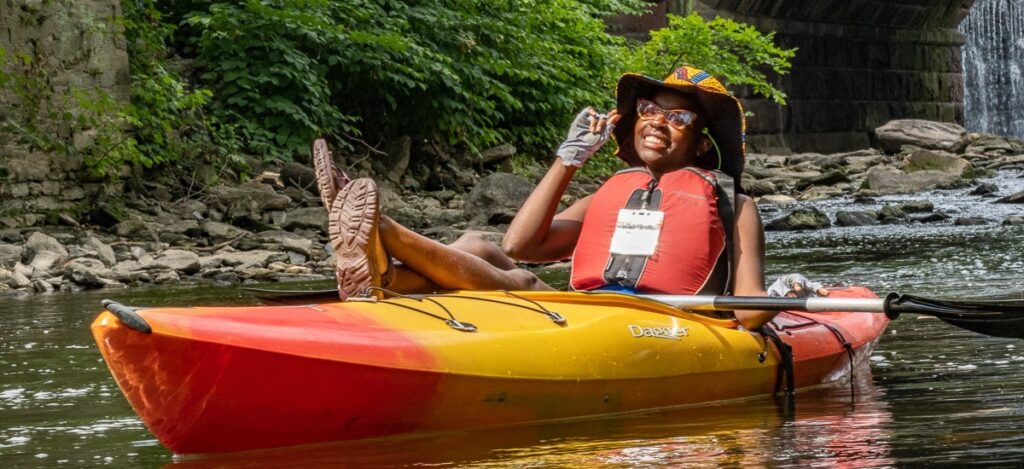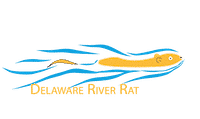The best way to see the upper Schuylkill River all at once is to join the Schuylkill River Sojourn https://schuylkillriver.org/programs-projects/schuylkill-river-sojourn/for a five-day paddling and camping adventure. It is an adventure with ease; meals, snacks, and entertainment are provided. The trip is guided by The Bad Adventures Company; they are acquainted with the Schuylkill’s every riffle and pool. Take it Outdoors Adventures schlepp your camping gear from site to site and in one place, deal with portaging boats. This is luxury camping. There is still work; it isn’t being on safari as a 19th-century aristocrat after all. There are hours of paddling. You do have to set up and break down your own camp, and most portages are a group effort with people helping to carry each other’s kayaks.
The complete trip is five days from Schuylkill Haven to center city Philadelphia. Camping takes place in parks that don’t usually allow it. The Schuylkill River Greenways folks do a marvelous job organizing the whole thing. Food is provided by a different group at each stop, bringing variety to the menu. Greenways staff follow the trip and are ready with programming and snacks at each break. Some programs are unabashedly educational; others are simply fun. Paddlers pick up the river’s history, art, and science as they rest from their labors. Or they can simply take a break at each stop; cell phones seem to play a role.
Paddlers can do as much or little of the trip as they like. Each evening a bus takes day-trippers to the morning start point, and on the last day, that bus will take the complete trip paddlers back to the original starting point in Pottstown. Frequently the most challenging part of any non-tidal paddling trip is arranging transportation to and from the endpoints of the trip. 
Every type of paddling craft is in this fleet except the indigenous dugout canoe. Touring kayaks, sit on tops, racing canoes, everyday canoes, folding boats, inflatable boats. They are brightly colored, making their passage celebratory. As the flotilla approaches them, great blue herons launch themselves and soar downstream, repeating the process until sensing their old fishing spot is safe enough to return to. It is hard to believe this is a river that has returned from the dead. The Schuylkill River was the first significant river reclamation project in this country. After years of silting with by-products of the coal industry, the river was a trickle through mounds of black culm. It was be dredged from Pottstown to the confluence with the Delaware River, a distance of over 100 miles. A paddler stirring the herons to action from the river’s wooded banks could be excused for thinking the river was always a sylvan paradise. Still, it is well to remember the continuous effort required to protect the essentials of life from our own depredations.
The Schuylkill offers variety; there are a few spots where the water rushes through rocks, providing a moment of excitement and the chance of getting wet. Other places are the picture of a lazy sunny day drifting downstream. There are plenty of places to run aground and rocks to get hung upon. And there are dams to portage around. The river was terraced with dams to bypass rapids and keep the canals full long ago.The guides do a great job of helping the flotilla negotiate the potential hazards, marking the way, providing encouragement and instruction as it is needed.
There has been a movement to showcase the waterways of the Delaware Watershed. Mostly this has taken the form of creating paths along the water’s edge using the right of ways of disused railroads, electric transmission lines, and canal towpaths. Schuylkill Greenways has been involved in this work, and the Sojourn extends that. The river is the original pathway, and traveling it develops a stronger appreciation for its value. Like so much of the Watershed, the Schuylkill represents the midpoint of what could turn out to be a tremendous success story. Bringing a river brought back from the dead is a good story, but the story, and the restoration process, are not complete. As more people appreciate the river and all it brings, a conduit of our history and culture, the source of our drinking water, and the place that brings solace from the pressures of modern life, perhaps the will to carry that story on will prevail.
The 2023 Sojourn will take place from June 17 to June 23.


